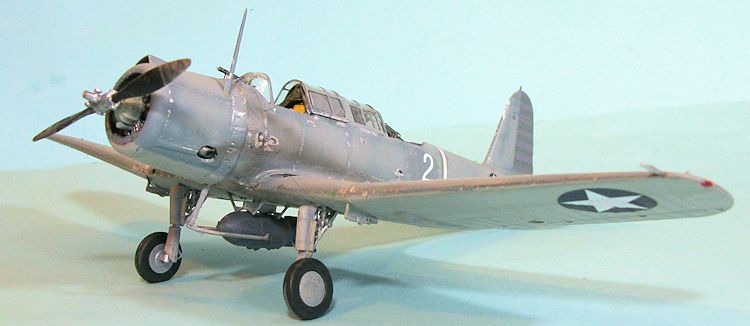
Accurate Miniatures 1/48 SB2U-3 'Vindicator'
| KIT #: | |
| PRICE: | $37.95 SRP |
| DECALS: | One option |
| REVIEWER: | Tom Cleaver |
| NOTES: |

| HISTORY |
The SB2U-1 and SB2U-2 was the
first monoplane dive bomber accepted into service by the U.S. Navy.
From the beginning, the airplane was not a success as a
dive bomber, since Vought was unable to come up with a way of braking the
airplane’s speed in a 70-degree dive.
The tactic of extending the landing gear did not
sufficiently slow the airplane.
The Northrop BT-1 - with its perforated dive flaps that
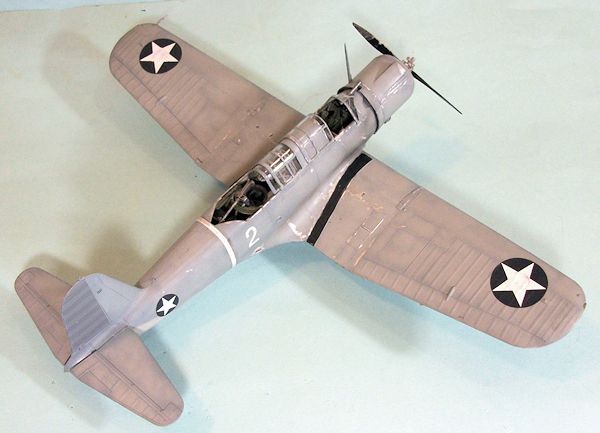 allowed
speed to be kept to under 270 knots in a dive, which allowed the pilot to
accurately aim the airplane at the target - showed much more potential, and was
ultimately to appear as the SBD Dauntless, the best dive bomber of the Second
World War.
allowed
speed to be kept to under 270 knots in a dive, which allowed the pilot to
accurately aim the airplane at the target - showed much more potential, and was
ultimately to appear as the SBD Dauntless, the best dive bomber of the Second
World War.
Nevertheless, in 1940 Vought
proposed a “long range” scout/dive bomber development of the design with
increased armament and armor, which the Navy accepted as the SB2U-3. Originally
developed as a floatplane, the performance of the XSB2U-3 on floats was so poor
that the concept was abandoned and the 57 SB2u-3s ordered were produced as land
planes and handed over to the Marines, since the Navy didn’t want them.
The SB2U-3, which had the same powerplant as the earlier
airplanes, with additional weight from four 50 caliber guns in the wings and
increased fuel supply, had an even poorer performance than its forebears.
VMSB-1 and VMSB-2 were equipped with airplane, now known
as the “Vindicator” in the summer of 1941.
The Vindicator at Midway:
VMSB-1, the “east coast” Marine
Scout-Dive Bomber unit, was renumbered VMSB-231 in October 1941 and sent to the
west coast as war clouds gathered in the Pacific.
In November, the unit was sent on to MCAS Ewa at Pearl
Harbor.
During the first week of December, 18 of the unit’s 24 Vindicators were
loaded aboard the “Saratoga”, for shipment on to Midway.
Following the attack on Pearl Harbor, which happened
before “Saratoga” could send the Vindicators on to Midway Island, the carrier
was recalled to Pearl Harbor, where the Marines found the Vindicators left
behind at Ewa had been destroyed in the Japanese attack.
On December 23, 1941, 18 SB2U-3s, accompanied by a PBY
for navigation, demonstrated their long-range capability when they made the
1,135 mile flight from Oahu to Midway in 9 hours and 45 minutes.
At Midway, the squadron joined the F2A-3s of VMF-221 as
Marine Air Group 22, the westernmost American unit in the Pacific, following the
surrender of Wake Island the week before.
Discovered in 1859 and annexed by
the United States in August 1867, Midway Atoll consists of Sand and Eastern
islands, surrounded by a coral reef less than six miles in diameter. The atoll
was used as a
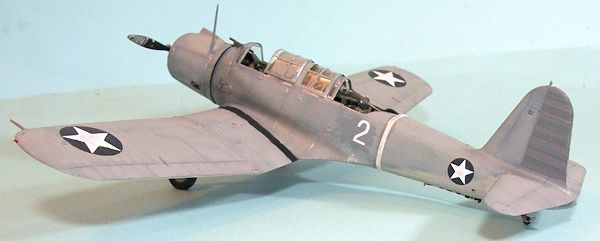 cable
station and airport for Pan American Airways’ China Clipper until March 1941,
when the U.S. Navy began construction of a naval air station. Completed in
August 1941, Midway NAS included a 5,300-foot runway on Eastern Island.
Midway entered the war on December 7 when the Japanese
destroyers Sazanami and
Ushio shelled the airfield.
With the outbreak of war, Midway became vitally
important, though at the time none of its personnel could have imagined how
important.
cable
station and airport for Pan American Airways’ China Clipper until March 1941,
when the U.S. Navy began construction of a naval air station. Completed in
August 1941, Midway NAS included a 5,300-foot runway on Eastern Island.
Midway entered the war on December 7 when the Japanese
destroyers Sazanami and
Ushio shelled the airfield.
With the outbreak of war, Midway became vitally
important, though at the time none of its personnel could have imagined how
important.
At the time of their departure for
Midway, the SB2U-3s of VMSB-231 were due for an overhaul that would have
included replacing the wing and fuselage fabric.
Suffering from heat, sunlight, and salt air on Midway,
the fuselage fabric went from bad to worse, and the squadron was reduced to
wrapping 4-inch medical tape over the worst areas to keep the fabric in place,
which was then doped over, resulting in all the dirt on the airplane at the
moment being preserved. under the dope.
These were the famous “white stripes” seen in photos.
No two airplanes had similar taping.
Through the first five months of
1942, the Vindicators would take off at 0400 for a morning anti-submarine
patrol, with an evening patrol taking off at 1730.
As one squadron member recalled, “In between, we’d
practice bombing during the day. There was a barge out in the lagoon, but we got
no practice in hitting a moving ship. Meanwhile, Japanese submarines were
watching us - they knew what we had. Every Friday night the Japanese shelled us,
but the three or four rounds they fired were not too effective considering that
the island was no more than 4 feet above sea level. We’d sit on top of our
dugout on Friday night, wondering where the shells would come from and where
they would go. Most went right over the island and into the lagoon. They
sometimes hit, making a hole 15 feet long, and we’d just fill it in.”
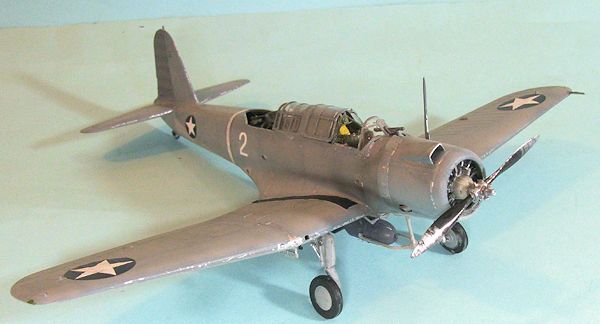 In February 1942, several VMSB-231 personnel were
sent back to MCAS Ewa to form new squadrons, and on March 1, 1942, the squadron
was redesignated VMSB-241, the “Sons of Satan.”
In February 1942, several VMSB-231 personnel were
sent back to MCAS Ewa to form new squadrons, and on March 1, 1942, the squadron
was redesignated VMSB-241, the “Sons of Satan.”
At the end of May., 1942, the
pilots were informed the war was coming to them, with the main Japanese fleet
set to hit Midway and invade it within a week. The squadron received 16 SBD-1
and SBD-2 airplanes a day later, to supplement the tired old SB2U-3sw
On June 4, 1942, the squadron was
ordered to take off at 0700 and attack the Japanese fleet.
Major Benjamin W. Norris led 12 SB2Us, though one had to
drop out with mechanical problems. Japanese carrier planes were attacking Midway
as they took off with bombs falling on the island. They were to rendezvous 40
miles east of the island, but when the SB2Us got there the SBDs were long gone.
The
Vindicators headed out, climbing at 200-300 feet per minute until they reached
8,000 feet, just above the clouds.
The weather over Midway on June 4
was clear, with scattered clouds. As they proceeded northwest toward the
Japanese fleet the cloud cover became more complete. By the time they were 25
miles from the projected attack point, the cloud cover was solid to broken, with
heavy clouds extending up to 8,000 feet. Between breaks in the overcast they
could see elements of the Japanese fleet.
The SB2U-3s were in three
four-plane sections, in a step-down formation when the Japanese Combat Air
Patrol found them and attacked.
Several gunners were killed before the little formation
got to the fleet.
Over the Japanese fleet, the
Vindicators dove n column formation through cloud breaks, still under attack by
Zeros.
They emerged into clear air at about 3,500-4,000 feet, in the vicinity
of a battleship, which Norris ordered them to attack; going after the carriers
would have meant flying across the entire fleet while under attack.
Two SB2Us, crewed by Lt. Andrew
Campion and Private Anthony J. Maday and 2nd Lt. James H. Marmande and Pfc Edby
M. Colvin, failed to return. Second Lieutenant Allan H. Ringblom ran out of
fuel, and had to ditch.
He and his gunner, Private E.L. Webb, were rescued by
PT-26. Lt. Cummings also had to ditch a few miles short of Midway, and was
rescued by PT-20.
The survivors of the morning
strike were refueled and rearmed.
They spent until 1900 waiting to go out, at which time
they were ordered to find and attack two burning Japanese carriers.
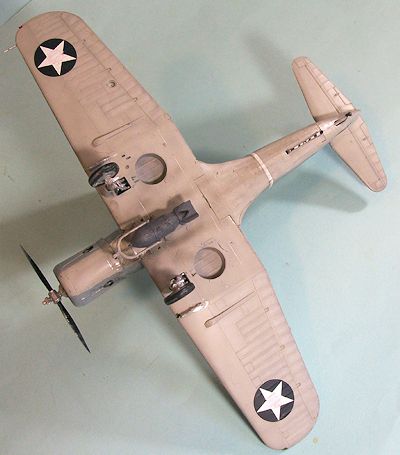 The SBDs, now led by Captain Marshall A. Tyler
following the death of squadron CO Major Henderson in the morning attack, went
out on their own. Major Norris led five SB2U-3s in a V formation.
The weather was bad, and they never found a target. In
the darkness the formation fell apart. Major Norris’ plane never came back, but
everyone else did.
The SBDs, now led by Captain Marshall A. Tyler
following the death of squadron CO Major Henderson in the morning attack, went
out on their own. Major Norris led five SB2U-3s in a V formation.
The weather was bad, and they never found a target. In
the darkness the formation fell apart. Major Norris’ plane never came back, but
everyone else did.
On June 5 VMSB-231 took off at 0430 to attack two
enemy cruisers, the Mogami and Mikuma, which had collided during the night.
The six SBDs were failed to finish off
Mogami, but the six SB2Us, led by Captain Fleming,
got a couple of hits on Mikuma, one a
solid hit forward, and another a bouncer off the stern. Fleming’s SB2U was hit
by anti-aircraft fire early in the attack and burst into flames;
he flew his plane into the ship, killing himself and his
gunner, PFC George A. Toms. The executive officer of Mikuma,
who survived the battle, said he thought Fleming was a very brave man because he
hit the after turret and put it out of action. He also caused a fire that was
sucked into Mikuma’s starboard air
intakes, suffocating her engineers.
VMSB-231 remained on Midway until
September 1943, when they returned to Pearl Harbor. Among the aircraft they left
behind were three surviving SB2U-3s, by that time they were the last Vindicators
being used by any American unit anywhere.
For carrying on his attack at cost
of his life and insuring that VMSB-241's attack on the Japanese fleet was
successful, Captain Richard A. Fleming was recognized with the posthumous award
of the Medal of Honor.
| THE KIT |
The SB2U-3 kit was released in
2005.
As with all those kits in the first release, the fuselage halves were
short-shot which created problems.
Later releases had fuselages without this problem.
Fortunately, this kit was one of those.
| CONSTRUCTION |
While the earlier SB2U-3 I did had
the cockpit painted in aluminum, later research demonstrated they were green,
with most assuming that to be Interior Green, which was the information I used
in pai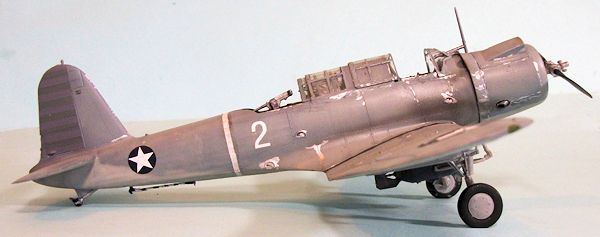 nting
this cockpit.
Of course, a week after it was completed, Dana Bell discovered
the fact that the SB2U-3s were delivered from the factory with the cockpits
painted entirely in Dull Dark Green.
Oh, well.
nting
this cockpit.
Of course, a week after it was completed, Dana Bell discovered
the fact that the SB2U-3s were delivered from the factory with the cockpits
painted entirely in Dull Dark Green.
Oh, well.
| COLORS & MARKINGS |
Once the model is constructed, the
big part of the work is still ahead for a modeler who wants to do one of the
VMSB-241 Vindicators at Midway.
As related, the conditions at Midway were primitive,
with the airplanes subject to sun, high humidity and saltwater air, without
benefit of being hangared at any time from their arrival at Midway until the
battle in June.
These conditions are death on paint, and what few photos of these
airplanes survive show the paint badly weathered and sun-faded.
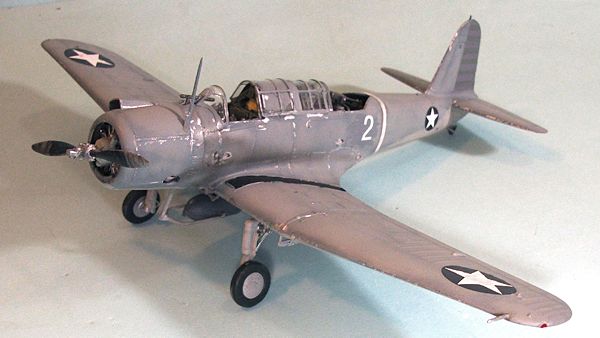 When the SB2U-3s were originally delivered in
1941, they were in a factory-applied scheme of overall Non-Specular Light Grey.
Some people think this color is the modern Light Gull
Grey, while others think it is something closer to the pre-war Navy color of
“Aircraft Grey” which had been used on the metal surfaces of Navy airplanes like
the F4B-4 prior to the adoption of aluminum lacquer on metal surfaces.
I spent an afternoon watching “Dive Bomber” in glorious
Technicolor, freeze-framing all the shots of overall-grey airplanes, and I think
the color is something close to Light Gull Grey, which I ended up using,
progressively lightened with white to give a multi-hue color.
This was applied over the entire model.
When the SB2U-3s were originally delivered in
1941, they were in a factory-applied scheme of overall Non-Specular Light Grey.
Some people think this color is the modern Light Gull
Grey, while others think it is something closer to the pre-war Navy color of
“Aircraft Grey” which had been used on the metal surfaces of Navy airplanes like
the F4B-4 prior to the adoption of aluminum lacquer on metal surfaces.
I spent an afternoon watching “Dive Bomber” in glorious
Technicolor, freeze-framing all the shots of overall-grey airplanes, and I think
the color is something close to Light Gull Grey, which I ended up using,
progressively lightened with white to give a multi-hue color.
This was applied over the entire model.
The Vindicators were given a
field-applied camouflage of Blue-Grey over the upper surfaces.
The Navy SB2U-1s and -2s were camouflaged with this
color on the lower surfaces of the folding wings, as camouflage when the
airplanes had their wings folded aboard a carrier (which is why the Corsair has
a similar camouflage). However, the Marine SB2U-3s were never going to be used
from carriers operationally.
From looking at the few pictures of VMSB-241 SB2U-3s, I
think the Blue Grey camouflage was only applied to the upper surfaces, and not
to the outer lower surfaces of the wings.
This is the result of a lot of staring at pictures and
comparing tonal values, as well as looking at the color footage taken by John
Ford at Midway, where the color of the lower surface appears lighter than the
very-faded upper surface.
This could be wrong, but it is “in character” with a
field-applied camouflage of airplanes at a period when the rules of what to
paint were not entirely clear.
Painting the upper surface started
with a very thin coat of Xtracrylix “Blue Grey,” applied so there were
“holidays” in the paint over the metal areas of the airframe, since it is
reported that these areas showed a lot of grey. This would be the case for
field-applied paint wearing off over a proper factory-applied paint in the
conditions the airplanes experienced.
I then lightened the Xtracrylix
“Blue Grey” and applied that to the fabric areas, and also used it to go over
the metal areas, to start fading the darker color.
I then applied a little light grey to this paint, and
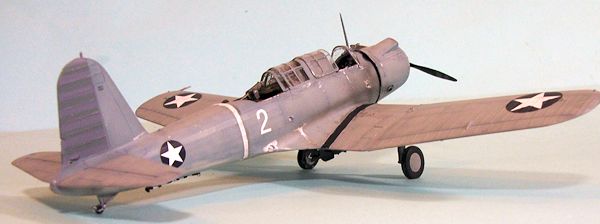 went over
the surfaces again, fading them in patches.
This was followed with an addition of white to the
paint, and I went over the model again.
When the paint looked sufficiently ravaged by sun,
humidity and salt air, I set the model aside to dry overnight.
When all was dry, I gave the model an overall coat of
Xtracrylix Gloss varnish.
went over
the surfaces again, fading them in patches.
This was followed with an addition of white to the
paint, and I went over the model again.
When the paint looked sufficiently ravaged by sun,
humidity and salt air, I set the model aside to dry overnight.
When all was dry, I gave the model an overall coat of
Xtracrylix Gloss varnish.
The first thing I did was apply
the medical tape, using some white stripe decals that were the proper scale
4-inch width.
I decided to do Vindicator #2, the airplane flown by Captain
fleming, which only had the tape wrapped completely around the fuselage just aft
of the cockpit as shown in Ford’s documentary.
Unfortunately, there are no photos of the left side of
the airplane, so I guessed that this was all.
When these decals had set, I airbrushed them with Tamiya
“Smoke”, since the photos show a dark area around all the tape, where they were
doped over dirty surfaces.
While the earlier release of this
kit had the pre-war 60-inch national insignia, this release had the more
accurate 40-inch roundels, which I used.
I also added the red centers, then overpainted them with
white as the Marines had done with the originals, leaving them so they could
still be seen through the paint.
All of the serials are
provided for the VMSB-241 Vindicators, so a modeler can do every one of them if
you want.
| FINAL CONSTRUCTION |
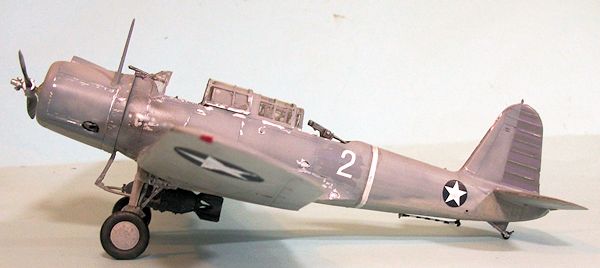 When the decals had set up, I airbrushed Tamiya “Smoke”
for the exhaust and “dinged” the airframe with aluminum paint applied with a
0000 brush. I
then gave the model a coat of Xtracrylix Satin Varnish, followed by a coat of
Xtracrylix Flat varnish, with Tamiya Flat Base added to get a dead-flat finish
to the model.
When the decals had set up, I airbrushed Tamiya “Smoke”
for the exhaust and “dinged” the airframe with aluminum paint applied with a
0000 brush. I
then gave the model a coat of Xtracrylix Satin Varnish, followed by a coat of
Xtracrylix Flat varnish, with Tamiya Flat Base added to get a dead-flat finish
to the model.
| CONCLUSIONS |
February 1013
If you would like your product reviewed fairly and fairly quickly, please contact the editor or see other details in the Note to Contributors.